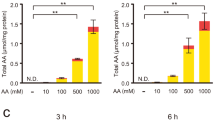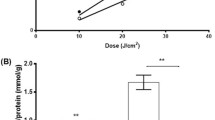Abstract
Ultraviolet Al (UVA1) radiation generates reactive oxygen species and the oxidative stress is known as a mediator of DNA damage and of apoptosis. We exposed cultured human cutaneous fibroblasts to UVA1 radiation (wavelengths in the 340–450-nm range with emission peak at 365 nm) and, using the alkaline unwinding method, we showed an immediate significant increase of DNA strand breaks in exposed cells. Apoptosis was determined by detecting cytoplasmic nucleosomes (enzyme-linked immunosorbent assay method) at different time points in fibroblasts exposed to different irradiation doses. In our conditions, UVA1 radiation induced an early (8 h) and a delayed (18 h) apoptosis. Delayed apoptosis increased in a UVA dosedependent manner. Zinc is an important metal for DNA protection and has been shown to have inhibitory effects on apoptosis. The addition of zinc (6.5 mg/L) as zinc chloride to the culture medium significantly decreased immediate DNA strand breaks in human skin fibroblasts. Moreover, zinc chloride significantly decreased UVA1-induced early and delayed apoptosis. Thus, these data show for the first time in normal cutaneous cultured cells that UVA1 radiation induces apoptosis. This apoptosis is biphasic and appears higher 18 h after the stress. Zinc supplementation can prevent both immediate DNA strand breakage and early and delayed apoptosis, suggesting that this metal could be of interest for skin cell protection against UVA1 irradiation.
Similar content being viewed by others
References
R. M. Tyrrell, UV-A (320–380 nm) radiation as an oxidative stress, inOxidative Stress: Oxidants and Antioxidants, H. Sies, ed., Academic, New York, pp. 57–83 (1991).
M. J. Peak and J. G. Peak, Hydroxyl radical quenching agents protect against DNA breakage caused by both 365 nm UV-A and gamma radiation,Photochem. Photobiol. 51, 649–652 (1990).
A. Schwarz, R. Bhardwaj, Y. Aragane, K. Mahnke, H. Riemann, D. Metze, et al., Ultraviolet-B-induced apoptosis of keratinocytes: evidence for partial involvement of tumor necrosis factor-α in the formation of sunburn cells,J. Invest. Dermatol. 104, 922–927 (1995).
D. E. Godar and A. D. Lucas, Spectral dependence of UV-induced immediate and delayed apoptosis: the role of membrane and DNA damage,Photochem. Photobiol. 62, 108–113 (1995).
B. R. Vowels, E. K. Yoo, and F. P. Gasparro, Kinetic analysis of apoptosis induction in human cell lines by UVA and 8-MOP,Photochem. Photobiol. 63, 572–576 (1996).
M. Wlaschek, J. Wenk, P. Brenneisen, K. Briviba, A. Schwarz, H. Sies, et al., Singlet oxygen is an early intermediate in cytokine-dependent ultraviolet-A induction of interstitial collagenase in human dermal fibroblasts in vitro,FEBS Letters 413, 239–242 (1997).
R. Lavker and K. Kaidbey, The spectral dependence for UVA-induced cumulative damage in human skin,J. Invest. Dermatol. 108, 17–21 (1997).
J. E. Coleman, Zinc proteins: enzymes, storage proteins, transcription factors, and replication proteins,Annu. Rev. Biochem. 61, 897–946 (1992).
D. K. Perry, M. J. Smyth, H. R. Stennicke, G. S. Salvesen, P. Duriez, G. G. Poirier, et al., Zinc is a potent inhibitor of the apoptotic protease, caspase-3,J. Biol. Chem. 272, 18,530–18,533 (1997).
F. W. Sunderman, The influence of zinc on apoptosis,Ann. Clin. Lab. Sci. 25, 134–142 (1995).
M. J. Richard, P. Guiraud, M. T. Leccia, J. C. B’eani, and A. Favier, Effect of zinc supplementation on resistance of cultured human skin fibroblasts toward oxidant stress,Biol. Trace Element Res. 37, 187–199 (1993).
M. T. Leccia, M. J. Richard, J. C. B’eani, H. Faure, A. M. Monjo, J. Cadet, et al., Protective effect of selenium and zinc on UV-A damage in human skin fibroblasts,Photochem. Photobiol. 58, 548–553 (1993).
M. O. Parat, M. J. Richard, S. Pollet, C. Hadjur, A. Favier, and J. C. B’eani, Zinc and DNA fragmentation in keratinocyte apoptosis: its inhibitory effect in UVB irradiated cells,J. Photochem. Photobiol. B: Biol 37, 101–106 (1997).
T. P. Akerboom and H. Sies, Assay of glutathione, glutathione disulfide and glutathione mixed disulfides in biological samples, in Methods in Enzymology Vol.77, Academic, New York, pp. 373–382 (1981).
W. A. Gunzler, H. Kremers, and L. Flohe, An improved coupled test procedure for glutathione peroxidase in blood,Z. Klin. Chem. Klin. Biochem. 12, 444–448 (1974).
S. L. Marklund and G. Marklund, Involvement of the Superoxide anion radical in the autooxidation of pyrogallol and a convenient assay of Superoxide dismutase,Eur. J. Biochem. 47, 469–474 (1974).
H. C. Birnboim and J. J. Jevcak, Fluorimetric method for rapid detection of DNA strand breaks in human white blood cells produced by low doses of radiation,Cancer Res. 41, 1889–1892 (1981).
M. J. Richard, P. Guiraud, A. M. Monjo, and A. Favier, Development of a simple antioxidant screening assay using human skin fibroblasts,Free Radical Res. Commun. 16, 303–314 (1992).
T. M. Bray and W. J. Bettger, The physiological role of zinc as an antioxidant,Free Radical Biol. Med. 8, 281–291 (1990).
P. Morlière, A. Moysan, R. Santus, G. Huppe, J. C. Mazière, and L. Dubertret, UVAinduced lipid peroxidation in cultured human fibroblasts,Biochim. Biophys. Acta 1084, 261–268 (1991).
S. Basu-Modak, P. Lüscher, and R. M. Tyrrell, Lipid metabolite involvement in the activation of the human heme oxygenase-1 gene,Free Radical Biol. Med. 20, 887–897 (1996).
M. J. Peak and J. G. Peak, Solar-ultraviolet-induced damage to DNA,Photodermatology 6, 1–15 (1989).
S. Orrenius, Mechanisms of oxidative cell damage, inFree Radicals: From Basic Science to Medicine, G. Poli, E. Albano, and M. U. Dianzani, ed., Birkhauser Verlag, Basel, pp. 47–64 (1993).
J. G. Peak, B. Pilas, E. J. Dudek, and M. J. Peak, DNA breaks caused by monochromatic 365 nm ultraviolet-A radiation or hydrogen peroxide and their repair in human epithelioid and xeroderma pigmentosum cells,Photochem. Photobiol. 54, 197–203 (1991).
P. J. Thornalley and M. Vasak, Possible role of metallothionein in protection against radiation-induced oxidative stress. Kinetics and mechanism of its reaction with Superoxide and hydroxyl radicals,Biochim. Biophys. Acta 827, 36–44 (1985).
L. S. Chubatsu and R. Meneghini (1993) Metallothionein protects DNA from oxidative damage,Biochem. J. 291, 193–198 (1993).
B. Stein, H. J. Rahmsdorf, A. Steffen, M. Litfin, and P. Herrlich, UV-induced DNA damage is an intermediate step in UV-induced expression of human immunodeficiency virus type 1, collagenase,c-fos, and metallothionein,Mol. Cell. Biol. 9, 5169–5181 (1989).
K. Hanada, K. Tamai, D. Sawamura, and I. Hashimoto, Dynamic changes in intracellular location of metallothionein in rat keratinocytes after ultraviolet-B irradiation,J. Invest. Dermatol. 110, 98–100 (1998).
E. J. Dudek, J. G. Peak, R. M. Roth, and M. J. Peak, Protection against UV-A induced photooxidative damage in mammalian cell lines expressing increased levels of metallothioneins,J. Free Radical Biol. Med. 9, 76 (1990).
A. W. Girotti, J. P. Thomas, and J. E. Jordan, Inhibitory effect of zinc II on free radical lipid peroxidation in erythrocyte membranes,Free Radical Biol. Med. 1, 395–401 (1985).
M. O. Parat, M. J. Richard, J. C. B’eani, and A. Favier, Involvement of zinc in intracellular oxidant/antioxidant balance,Biol. Trace Element Res. 60, 187–204 (1997).
S. Morana, J. Li, E. W. Springer, and A. Eastman, The inhibition of etoposide-induced apoptosis by zinc is associated with modulation of intracellular pH,Int. J. Oncol. 5, 153–158 (1994).
T. M. Buttke and P. A. Sandstrom, Oxidative stress as a mediator of apoptosis,Immunol. Today 15, 7–10 (1994).
T. A. Sarafian and D. E. Bredesen, Is apoptosis mediated by reactive oxygen species?Free Radical Res. Commun. 21, 1–8 (1994).
G. W. Verhaegh, M. O. Parat, M. J. Richard, and P. Hainaut, Modulation of p53 protein conformation and DNA-binding activity by intracellular chelation of zinc,Mol. Carcinog. 21, 205–214 (1998).
U. Zabel, R. Schreck, and P. A. Bauerle, DNA binding of purified transcription factor NFkB. Affinity, specificity, Zn++ dependence, and half-site recognition,J. Biol. Chem. 266, 252–260 (1991).
Author information
Authors and Affiliations
Rights and permissions
About this article
Cite this article
Leccia, MT., Richard, MJ., Favier, A. et al. Zinc protects against ultraviolet A1-induced DNA damage and apoptosis in cultured human fibroblasts. Biol Trace Elem Res 69, 177–190 (1999). https://doi.org/10.1007/BF02783870
Received:
Accepted:
Issue Date:
DOI: https://doi.org/10.1007/BF02783870




